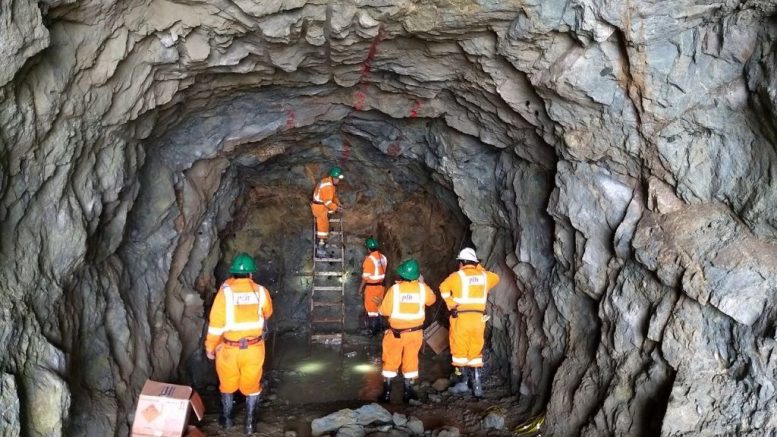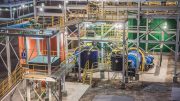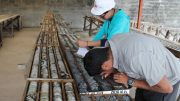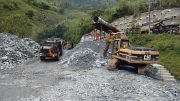Lupaka Gold (TSXV: LPK) has tabled a positive preliminary economic assessment of its fully funded, 316 sq. km Invicta underground gold-copper project in Peru, 120 km north of Lima. It aims to jump into production by the end of 2018 with low start-up costs and use the ensuing cash flow to expand its operation.
Its initial six-year mine plan outlines a 350-tonne-per-day operation on a small but high-grade subset of Invicta’s Atenea vein through sub-level, long-hole open stoping via an adit on the project’s underground structure, 3,400 metres above sea level.
“The resource has enough in the indicated category to support 24 years of mining at 350 tonnes a day, but that’s not what we want to accomplish in the long run,” Lupaka president and CEO Will Ansley says in a telephone interview with The Northern Miner.

Lupaka is upgrading the road that runs across Lacsanga land, from the highway to Invicta. The road will support 30 tonne trucks and remain after Lupaka leaves. Credit: Lupaka Gold.
“We need to get in there and show the community that we’re a good operator and a good partner, and we value them, and then we can expand production and ultimately build a plant on-site. That’s the goal.”
Lupaka is not the first company to try produce at Invicta. The property was originally owned by Barrick Gold (TSX: ABX; NYSE: ABX) and then by Andean American. Andean permitted the project to produce 5,200 tonnes per day and tabled a full feasibility study for a combined open-pit and underground mine. It also spent more than US$15 million on Invicta, part of which helped build the 1.2 km underground infrastructure.
Andean never got the project running, however, due to a lack of community support and projected capital expenses that exceeded a billion dollars.
“They floundered and eventually ran out of money pursuing that concept, and we acquired it in the downturn for a very reasonable price,” Ansley says.
At the time Lupaka was focused on another gold asset called Crucero, located in southern Peru. Crucero has 30.9 million indicated tonnes grading 1.02 grams gold per tonne for 1 million oz. gold. It sold Crucero in November 2017 to GoldMining (TSXV: GOLD) for 3.5 million shares and $750,000 in cash. After that, Lupaka became fully funded to bring Invicta into production.
The company financed US$5.5 million in February 2018, and now has US$7.6 million in cash. It’s enough to finish pre-production, which Lupaka says will cost US$4.3 million. Lupaka saved money on capital expenses by using its infrastructure — which includes a 65-person camp — and trucking mineralized material to a toll-milling facility rather than build a plant on-site. Lupaka excludes the US$1 million it spent buying back a 1% production royalty from Franco Nevada (TSX: FNV; NYSE: FNV) in 2017 from its capital expense estimates.
If the project goes to production, Lupaka anticipates 670,000 tonnes at 8.6 equivalent grams gold for 185,000 equivalent oz. gold over the first six years, generating an average annual cash flow of US$8.2 million. The project has an after-tax net present value of US$43.4 million at a 5% discount rate.

More than 70% of people in the nearby Lacsanga communities work with Lupaka. Credit: Lupaka Gold.
“You can get a sense of how wonderful the economics are on the project,” Ansley says. “The project has highly robust economics because it has very low capital expenditure and no time decay — it’s ready to go [and] permitted. With a lot of these projects the economics are hampered because you have to wait two or three years to build things that cost hundreds of millions of dollars. We don’t have that.”
Lupaka has the project permitted, and wants to raise production to 1,000 tonnes per day. It also wants to keep drilling and expand its resource. Lupaka could mine for eight years based on its current resource model, but Ansley says he’d like to see that number “rise to 10 years and beyond.”

A portal at Lupaka Gold’s Invicta gold-copper project in Peru, 120 km north of Lima. Credit: Lupaka Gold.
The Invicta project has a resource of 3 million indicated tonnes at 5.78 equivalent grams gold per tonne for 558,000 equivalent oz. gold, based on drilling by Barrick and Andean. Lupaka itself has not drilled the property, but has taken two bulk samples for a combined 1,000 tonnes. Ansley says the company’s head of exploration is planning this year’s drill program, but doesn’t want to send an exploration crew underground until the mine contractor has rehabilitated the infrastructure.
Besides updating the underground workings, Lupaka will spend a quarter of its capital expenses on updating a road that supports 30-tonne trucks going to the toll miller. The US$1-million road program will work around the local Lacsanga communities, which Ansley says have been supportive of Lupaka so far.
Lupaka has an agreement with Lacsanga to cross their land and use their road to access its site.
“Part of our agreement stipulates that where possible we will employ them,” Ansley says. “Seventy percent of their community is either employed by us or working with us indirectly through service jobs, so it’s a very strong relationship that’s growing, and we’re very pleased and proud of it.”
Lupaka also has its Josnitoro gold project in southern Peru, 800 km by road southeast of Lima. The company can earn a 65% interest in Josnitoro from Hochschild Mining (LON: HOC), but must have an exploration agreement in place by the end of March. Ansley says Lupaka only received funding mid-2017 to do the exploration, and can’t “definitively say” Lupaka will meet its deadline.
“We’re going to ask for an extension,” Ansley says. “I don’t know if we’ll receive it or not, but if we are allowed to do exploration and if we are successful in getting the community agreement, we have a budget to do exploration there in 2018.”
Lupaka’s exploration budget for both properties is US$1 million.
In 2018, the company plans to sign an off-take agreement for Invicta, sign a milling contract and engineer potentially more production phases, as well as explore its properties. By year-end, Ansley says Lupaka wants to understand the timeline and cost of building a plant on-site.
Shares of Lupaka are valued at 23¢, within a 52-week range of 11¢ to 29¢. The company has a $27-million market capitalization.






Be the first to comment on "Lupaka ramps up to underground production at Invicta"